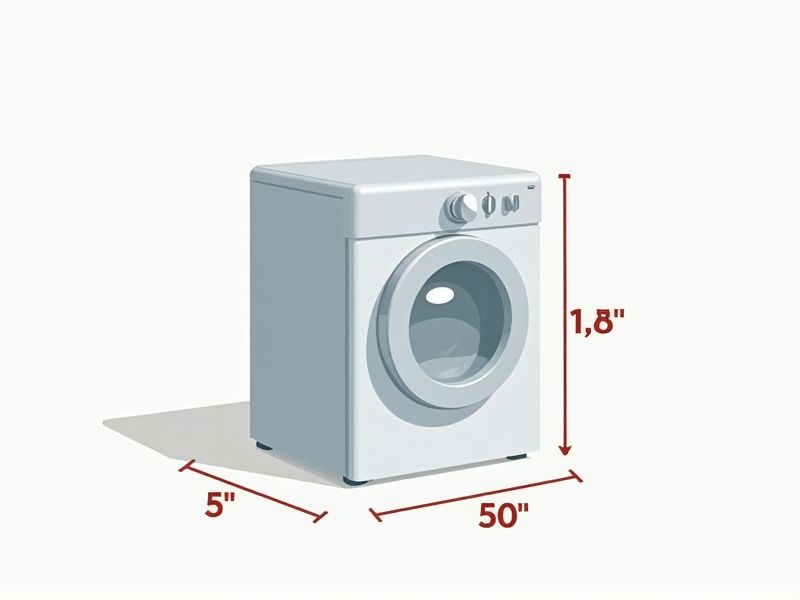
When planning your kitchen layout, knowing the standard dimensions of common kitchen appliances can help you make smart decisions. Most freestanding refrigerators range from 30 to 36 inches wide, 66 to 70 inches tall, and about 29 to 35 inches deep. Standard dishwashers are typically 24 inches wide, 24 inches deep, and 35 inches high, while most stoves and ovens measure around 30 inches in width and 25 to 27 inches in depth. Keeping these measurements in mind ensures your appliances will fit comfortably and function efficiently in your kitchen space.
Refrigerator Width
The standard width of residential refrigerators typically ranges from 30 to 36 inches, accommodating various kitchen layouts and space constraints. A 36-inch wide refrigerator usually offers a larger interior capacity, often exceeding 20 cubic feet, ideal for families or those who cook frequently. Many modern models feature additional configurations, such as French doors and side-by-sides, maximizing accessibility and organization of food items. When selecting a refrigerator, consider your kitchen's dimensions and your storage needs to ensure optimal functionality.
Dishwasher Height
The standard height for most dishwashers ranges from 32 to 34 inches, allowing seamless integration into kitchen cabinetry. This height accommodates both undercounter and standalone models, providing flexibility in design and functionality. You may find that certain brands offer adjustable feet, enabling precise leveling to match your kitchen setup. Ensuring your dishwasher meets standard height specifications can significantly improve user experience and aesthetic harmony in your kitchen environment.
Oven Depth
The standard oven depth typically measures between 24 to 30 inches, accommodating various kitchen layouts while ensuring efficient cooking. A depth of 24 inches is most common for built-in models, allowing for seamless integration with cabinetry. Many countertop ovens, however, can vary from 15 to 20 inches in depth, making them more versatile for limited spaces. When choosing an oven, consider your kitchen's dimensions and your cooking habits to optimize space and functionality.
Microwave Size
When selecting a kitchen microwave, size is a critical factor to consider, with standard capacities typically ranging from 0.7 to 2.2 cubic feet. A compact 0.7 cubic foot microwave is perfect for small kitchens or dorm rooms, while a larger 2.2 cubic foot model can accommodate family-sized meals and larger dishes. Interior dimensions often play an essential role, affecting how well your microwave can fit various cookware or dishes, with some designs featuring turntables that enhance cooking efficiency. Your choice in size can significantly impact countertop space and usability, influencing how often you will use this essential kitchen appliance.
Cooktop Dimensions
Cooktop dimensions typically range from 30 to 36 inches in width, accommodating various kitchen sizes and layouts. A common configuration includes four to six burners, allowing for versatile cooking options such as boiling, sauteing, and simmering. For an optimal kitchen design, ensure a minimum clearance of 30 inches above the cooktop to comply with safety standards. When selecting a cooktop, consider how its dimensions fit your countertop space and complement your overall kitchen aesthetics.
Range Width
The standard kitchen appliance range typically measures between 30 to 36 inches in width, accommodating both compact urban kitchens and spacious culinary areas. This width provides ample cooking surface for multiple dishes, with most models featuring four to six burners and an oven capacity ranging from 4.0 to 6.0 cubic feet. You can enhance your cooking experience with additional features like convection ovens and steam cooking options, which are increasingly popular. When selecting a range, consider the specific dimensions of your kitchen layout to ensure optimal functionality and aesthetics.
Cabinet Depth
The standard kitchen cabinet depth measures 24 inches, accommodating the majority of kitchen appliances for an efficient workflow. This depth allows for the installation of dishwashers, ovens, and refrigerators, ensuring a seamless integration into your kitchen layout. Many appliances are designed to fit flush with the cabinet fronts, providing a streamlined appearance while optimizing space. When planning your kitchen, considering appliance dimensions, which often range from 15 to 36 inches in width, is crucial for maximizing both functionality and aesthetic appeal.
Hood Vent Height
The recommended height for kitchen hood vents typically ranges from 24 to 30 inches above the cooking surface, ensuring optimal performance. Installing your hood at the correct height can enhance airflow, effectively removing smoke, grease, and odors during cooking. For professional-grade ranges, a height of 30 to 36 inches is often preferred to accommodate larger burners and cooking styles. Ensuring your vent hood meets these height standards not only improves safety but also complies with building codes, making your kitchen more efficient and pleasant to use.
Sink Size
The standard kitchen sink size typically measures 22 inches by 30 inches for a single basin or 33 inches for a double basin. You may encounter varying designs, such as top-mount or under-mount, which affect the overall aesthetic and functionality. A deep sink, often around 9 to 10 inches in depth, offers practical usability for washing larger pots and dishes. Choosing the right sink size can greatly enhance your kitchen workflow and complement your overall design.
Freezer Capacity
When selecting a kitchen appliance, the freezer capacity is a crucial factor to consider. Most modern freezers offer capacities ranging from 5 to 25 cubic feet, accommodating varying storage needs for families of different sizes. For ideal organization, look for features such as adjustable shelving and designated compartments, which can enhance the usability of your freezer space. A well-chosen freezer capacity ensures that your frozen goods remain readily accessible while optimizing your kitchen efficiency.
